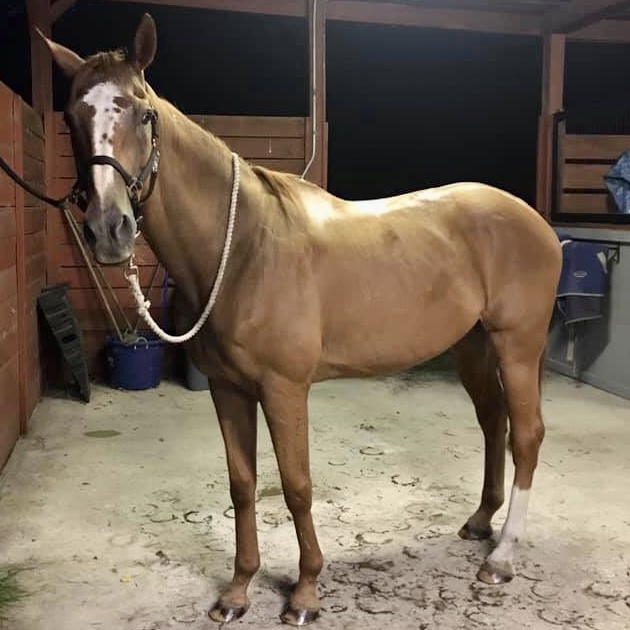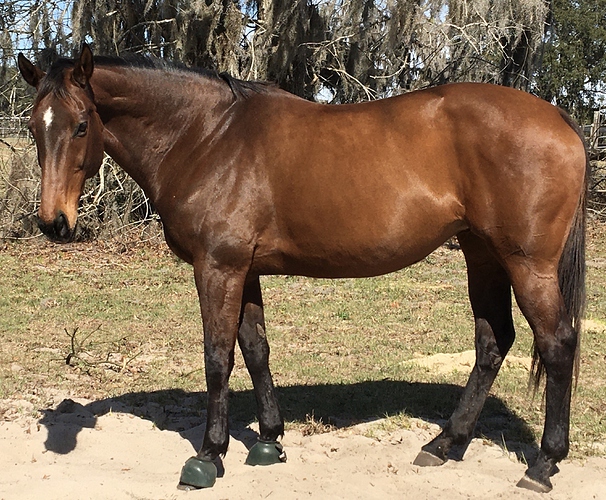I am looking for any and all honest advice on putting weight on hard keepers. I’ve had horses for over 15 years and nursed many back to health but my new one is stumping me. Please help! The usual things don’t seem to be making any difference.
4 months ago I took in an OTTB to be a companion to my other older horse. He was given to me for free by someone looking to re-home him because he had been injured (suspensory), but he appeared healthy overall and was in a nice stable when we picked him up. I thought he looked lean, but what OTTB doesn’t? He was in heavy work before I got him and I planned to retire him to mostly pasture pet with only light riding. My vet came out right away and gave him a clean bill of health - no dental work needed, no obvious ulcers, just told me to keep trying to fatten him up.
He gets a mix of grass/alfalfa hay, small square bales, it is free-choice available 24/7 but it gets topped up with about 20lbs of hay alone each day. I felt he needed a little boost calorie-wise, so I started supplementing this hay with soaked alfalfa pellets and beet pulp - he loves that. In addition to this, I offer one serving daily of senior feed, with an added fat supplement. The senior feeds I alternated between Triple Crown Senior and Sentinel Senior because these seemed to have the highest protein and fat percent. The fat supplement I originally used Cool Calories but he tried very hard to avoid it, so I switched to Farnam Weight builder and he’s eating that now. He also gets a variety of treats and a couple scoops of oats here and there, carrots, apples, lots of kisses.
But he didn’t seem to be making much improvement - so I had a fecal count done, but it came back all clear. The vet came out again, and said his teeth were still just fine. He was blanketed all this winter. I’ve reached out to the vet a third time now to consider treating with UlcerGard even though he doesn’t react on the ulcer point test.
The only thing different about his life with me now and his life with his previous family is that they had hind-shoes on him. When I picked him up his previous owner made a comment I remember, and said “I was finally able to get muscle on his back-end with a lift on his right hoof.” My farrier wanted to take his shoes off for the winter right away - but is there anyway that having that lift under his right foot could make such a difference to the fat/muscle in his rump?
I thought that his previous owners seemed very responsible and honest, but when I requested records from the vet they didn’t pass them on - they just wrote out a summary of latest problems with his suspensory (which has since healed just fine) and made me hard copies of the scans of his leg. The rest of his health history wasn’t reported on. Is there something possibly very bad here that they didn’t disclose that you recommend I have my vet go looking for?
Is there any other specific brand/feed that I should really try? And is there a specific supplement you would recommend?
Besides ulcers and teeth, is there something specific you think I should ask my vet to directly look for or test? Horse has absolutely no other symptoms.
Have you ever done a treatment for ulcers without scoping or do you have to scope first to confirm ulcers? How many days of treatment did you do and did you see a positive result in weight gain afterwards?
Please be realistic with me - this horse is 15 years old and has worked hard his entire life. Am I being unrealistic about how much weight he may be able to gain? If you have a hard-keeper I’d love to see a photo of them and for you to share what you do to keep them fat, especially in the winter. Usually I can see a difference in 4 months - do I need to be more patient this time?
Thanks so much! I appreciate all responses and if you have any ideas for me I haven’t considered yet, please let me know.


